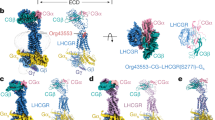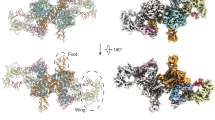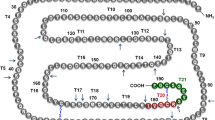Abstract
The β subunit of human choriogonadotropin (hCGβ) and its asialoderivative were digested with trypsin and then reduced and S-carboxymethylated. A series of peptides were purified which corresponded to residues 1–43, 44–95, 96–114, and 123–145 of the 145 amino acid residue glycoprotein. The two N-linked oligosaccharides were present on the amino terminal peptide, and three of the four O-linked oligosaccharides were present on the carboxy terminal peptide. Circular dichroic spectra between 190–240 nm were obtained on reduced, S-carboxymethylated (RCM) hCGβ and the above peptides, both in aqueous solution and in the helicogenic solvent 80% (vol/vol) trifluoroethanol (TFE). In aqueous solution there was evidence of only limited helicity in the peptides and RCM-hCGβ however, in the presence of TFE, peptides 1–43 and 44–95 exhibited significant helicity, as did the full-length linear chain. The helicity developed in TFE by RCM-hCGβ appears much greater than that which occurs in the native, disulfide-intact form, thus suggesting that the disulfides prevent expression of helicity in regions with α-helix potential. Application of the Chou-Fasman secondary structure predictive algorithm to hCGβ suggested that several regions of helix potential, in particular regions 14–21, 59–69, and perhaps 80–88, may account for much of the helicity observed in peptides 1–43 and 44–95, respectively, in TFE. The region from 96–145 has no significant potential for helicity, consistent with the measured circular dichroic spectra of peptides 96–114 and 123–145. These results demonstrate that helicity can occur in the linear form of hCGβ, and this secondary structure can best be attributed to the amino terminal and the middle portion of the molecule. Several potential regions of β-structure and β-turns were also suggested.
Similar content being viewed by others
References
Ambler, R. P. (1972).Methods Enzymol. 25, 143–154.
Bewley, T. A., and Yang, J. T. (1980). InHormonal Proteins and Peptides, Vol. 9 (Li, C. H., ed.), Academic Press, New York, pp. 175–238.
Birken, S., and Canfield, R. E. (1977).J. Biol. Chem. 252, 5386–5392.
Birken S., and Canfield, R. E. (1978). InStructure and Function of the Gonadotropins (McKerns, K. W., ed.), Plenum Press, New York, pp. 47–88.
Birken, S., Canfield, R., Agosto, G., and Lewis, J. (1982).Endocrinology 110, 1555–1563.
Birken, S., Kolks, M. A. G., Amr, S., Nisula, B., and Puett, D. (1986).J. Biol. Chem. 261, 10719–10727.
Birken, S., Kolks, M. A. G., Amr, S., Nisula, B., and Puett, D. (1987).Endocrinology 112, 657–666.
Canfield, R. E., and Morgan, F. J. (1973). InMethods in Investigative and Diagnostic Endocrinology, Vol. 2B (Berson, S. A., and Yalow, R. S., eds.), North Holland, Amsterdam, pp. 727–733.
Carlsen, R. B., Bahl, O. P., and Swaminathan, N. (1973).J. Biol. Chem. 248, 6810–6827.
Chang, C. T., Wu, C.-S. C., and Yang, J. T. (1978).Anal. Biochem. 91, 13–31.
Chen, Y.-Y., Yang, J. T., and Chau, K. H. (1974).Biochemistry 13, 3350–3359.
Chou, P. Y., and Fasman, G. D. (1978).Annu. Rev. Biochem. 47, 251–276.
Cole, L. A., Birken, S., and Perini, F. (1985).Biochem. Biophys. Res. Commun. 126, 333–339.
Compton, L. A., and Johnson, Jr., W. C. (1986).Anal. Biochem. 155, 155–167.
Creighton, T. E. (1988).Proc. Natl. Acad. Sci. USA 85, 5082–5086.
Endo, Y., Yamashita, K., Tachibana, Y., Tojo, S., and Kobata, A. (1979).J. Biochem. 85, 669–679.
Fiddes, J. C., and Talmadge, K. (1984).Rec. Progress Horm. Res. 40, 43–74.
Garnier, J. (1978). InStructure and Function of the Gonadotropins (McKerns, K. W., ed.) Plenum Press, New York, pp. 381–414.
Garnier, J., Salesse, R., and Pernollet, J. C. (1974).FEBS Letters 45, 166–171.
Giedroc, D. P., Ling, N., and Puett, D. (1983).Biochemistry 22, 5584–5591.
Gordon, W. L., and Ward, D. N. (1986). InLuteinizing Hormone Action and Receptors (Ascoli, M., ed.), CRC Press, Inc., Boca Raton, pp. 173–197.
Guidice, L. C., and Pierce, J. G. (1978). InStructure and Function of the Gonadotropins (McKerns, K. W., ed.), Plenum Press, New York, pp. 81–110.
Hammonds, R. G., Jr., Hammonds, A. S., Ling, N., and Puett, D. (1982).J. Biol. Chem. 257, 2990–2995.
Hilgenfeldt, U., Merz, W. E., and Brossmer, R. (1974).Hoppe-Seyler's Z. Physiol. Chem. 355, 1051–1057.
Holladay, L. A., and Puett, D. (1975).Arch. Biochem. Biophys. 171, 708–720.
Hopp, T. P., and Woods, K. R. (1981).Proc. Natl. Acad. Sci. USA 78, 3824–3828.
Kessler, M. J. Reddy, M. S., Shah, R. H., and Bahl, O. P. (1979a).J. Biol. Chem. 254, 7901–7908.
Kessler, M. J., Mise, T., Ghai, R. D., and Bahl, O. P. (1979b).J. Biol. Chem. 254, 7909–7914.
Keutmann, H. T., Charlesworth, M. C., and Mason, K. A., Ostrea, T., Johnson, L., and Ryan, R. J. (1987).Proc. Natl. Acad. Sci USA 84, 2038–2042.
Keutmann, H. T., Charlesworth, M. C., Kitzmann, K., Mason, K. A., Johnson, L., and Ryan, R. J. (1988).Biochemistry 27, 8939–8944.
Keutmann, H. T., Masan, K. A., Kitzmann, K., and Ryan, R. J. (1989).Mol. Endo. 3, 526–531.
Krystek, S. R., Jr., Dias, J. A., and Reichert, L. E., Jr. (1985).Endocrinology 117, 1110–1124.
Morgan, F. J., Birken, S., and Canfield, R. E. (1973).Mol. Cell Biochem. 2, 97–99.
Morgan, F. J., Canfield, R. E., Vaitukaitis, J. L., and Ross, G. T. (1974).Endocrinology 94, 1601–1606.
Morgan, F. J., Birken, S., and Canfield, R. E. (1975).J. Biol. Chem. 250, 5247–5258.
Nelson, J. W., and Kallenbach, N. R. (1987).Proteins: Structure, Function, and Genetics 1, 211–217.
Pierce, J. G., and Parsons, T. F. (1981).Annu. Rev. Biochem. 50, 465–495.
Puett, D., Ascoli, M., and Holladay, L. A. (1974). InHormone Binding and Target Cell Activation of the Testis (Dufau, M. L., and Means, A. R., eds.), Plenum Press, New York, pp. 109–124.
Puett, D., Ryan, R. J., and Stevens, V. C. (1982).Internatl. J. Peptide Protein Res. 19, 506–513.
Ryan, R. J., Keutmann, H. T., Charlesworth, M. C., McCormick, D. J., Milius, R. P., Calvo, F. O., and Vutyavanich, T. (1987).Rec. Progr. Hormone Res. 43, 383–422.
Ryan, R. J., Charlesworth, M. C., McCormick, D. J., Milius, R. P., and Keutmann, H. T. (1988).FASEB J. 2, 2661–2669.
Stevens, V. C., Chou, W.-S., Powell, J. E., Lee, A. C., and Smoot, J. (1986).Immunology Lett. 12, 11–18.
Strickland, T. W., and Pierce, J. G. (1983).J. Biol. Chem. 258, 5927–5932.
Strickland, T. W., and Puett, D. (1983).Internal. J. Peptide Protein Res. 21, 374–380.
Strickland, T. W., and Pierce, J. G. (1985).J. Biol. Chem. 260, 5816–5819.
Strickland, T. W., Parsons, T. F., and Pierce, J. G. (1985). InLuteinizing Hormone Action and Receptors (Ascoli, M. A., ed.), CRC Press, Inc., Boca Raton, pp. 1–15.
Tsou, C.-L. (1988).Biochemistry 27, 1809–1812.
Wright, P. E., Dyson, H. J., and Lerner, R. A. (1988).Biochemistry 27, 7167–7175.
Author information
Authors and Affiliations
Rights and permissions
About this article
Cite this article
Puett, D., Birken, S. Helix formation in reduced, S-carboxymethylated human choriogonadotropin β subunit and tryptic peptides. J Protein Chem 8, 779–794 (1989). https://doi.org/10.1007/BF01024902
Received:
Published:
Issue Date:
DOI: https://doi.org/10.1007/BF01024902




